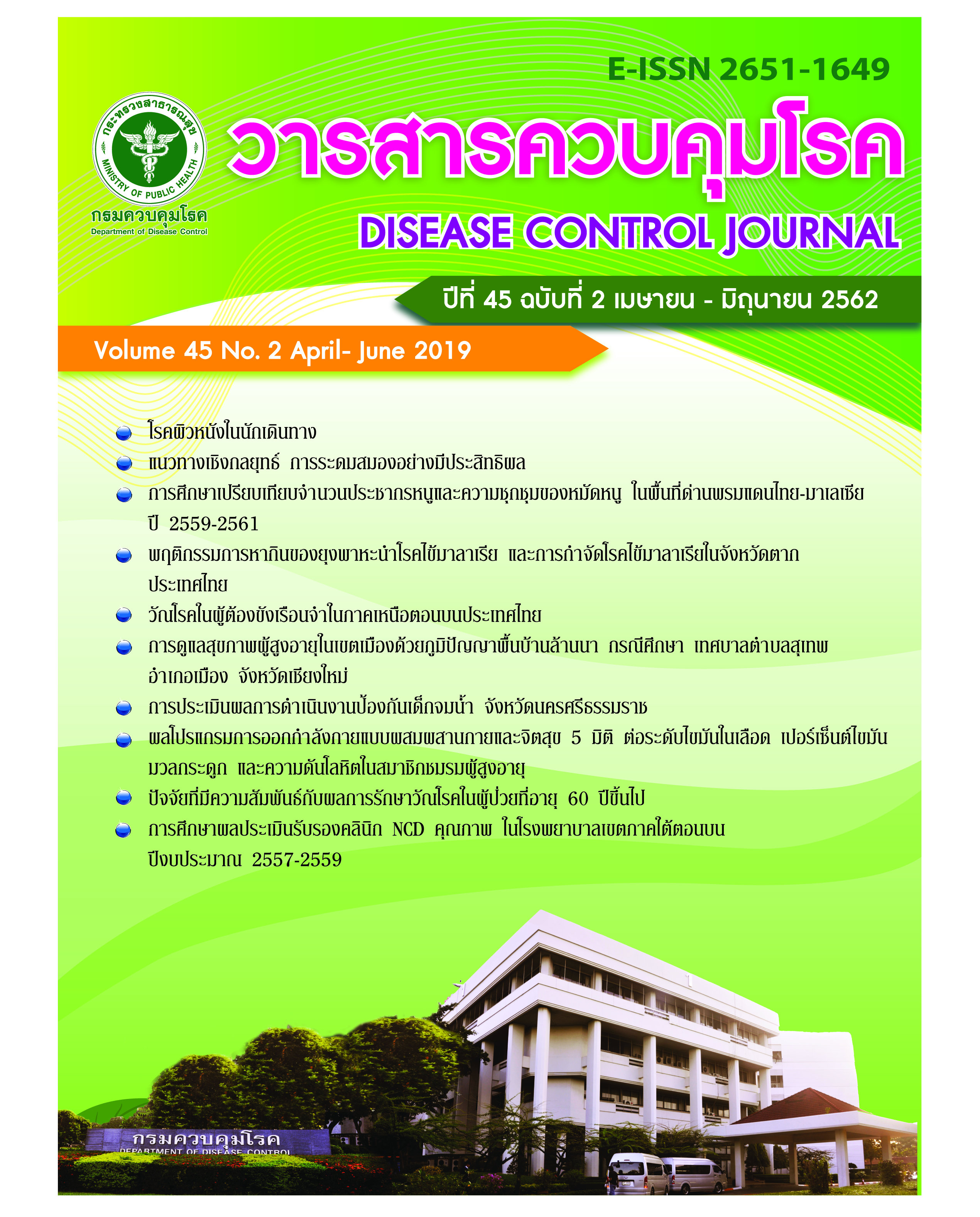โรคผิวหนังในนักเดินทาง
DOI:
https://doi.org/10.14456/dcj.2019.1คำสำคัญ:
โรคผิวหนัง, เวชศาสตร์การเดินทางบทคัดย่อ
การเดินทางก่อให้เกิดความไม่สมดุลขององค์ประกอบสามด้านทางระบาดวิทยา ได้แก่ host, agent และenvironment ทำให้เพิ่มความเสี่ยงที่จะเกิดการเจ็บป่วย โรคผิวหนังเป็นโรคที่พบได้บ่อยในนักเดินทาง ได้แก่ โรคติดเชื้อ การกัดต่อยของแมลงและสัตว์ โรคผิวหนังอักเสบ โรคจากปัจจัยทางกายภาพ อาการแสดงทางผิวหนังอาจเป็นอาการแสดงนำของโรคระบาดที่สำคัญ ซึ่งทำให้เราสามารถวินิจฉัยโรคและควบคุมป้องกันการแพร่ระบาดของโรคได้ทันท่วงที ข้อมูลด้านระบาดวิทยา สถานการณ์โรคจะมีประโยชน์อย่างมากในการวินิจฉัยโรค การป้องกันโรคโดยการระมัดระวังเรื่องสุขอนามัยและมีอุปกรณ์ป้องกันที่เหมาะสม
Downloads
เอกสารอ้างอิง
2. Leder K, Torresi J, Libman MD, Cramer JP, Castelli F, Schlagenhauf P, et al. GeoSentinel Surveillance of illness in returned travelers, 2007-2011. Ann Intern Med 2013;158:456-68.
3.Marks JG, Miller JJ. Lookingbill and Marks’ principles of dermatology. 4th ed. Philadelphia: Saunders Elsevier; 2000.
4.William JD, Berger T, ElstonD. Andrews' diseases of the skin: Clinical Dermatology. 12th ed. Philadelphia: Saunders Elsevier; 2015.
5. Nelson SA, Warschow. Protozoa and worms. In: Bolognia JL, Schaffer JV, Cerroni L, editors. Dermatology. 3th ed. New York: Elsevier; 2012. p. 1391-421.
6. Leelayoova S, Siripattanapipong S, Manomat J, Piyaraj P, Tan-Ariya P, Bualert L, et al. Leishmaniasis in Thailand: a review of causative agents and situations. Am J Trop Med Hyg 2017;96:534-42.
7. Suh KN, Keystone JS. Helminthic infections. In: Goldsmith LA, SI K, Gilchrest BA, Paller AS, Leffell DJ, Wolff K, editors. Fitzpatrick's dermatology in general medicine. 8th ed. New York: McGraw-Hill; 2012. p. 2544-68.
8. Beeching N, Gill G. Tropical medicine (lecture notes). 7th ed. Oxford: Wiley-Blackwell; 2014.
9. The National Broadcasting Services of Thailand channel 11 (NBT). Interview: Mahasarakham University research on black fly in Thailand [Internet]. [cited 2018 Oct 15]. Available from: https://www.youtube.com/watch?v=rpEAM_dyA1g
10. Weiss R. Dermatological manifestations in travel medicine. Dermatology 2005;23:121-5.
11. Freedman DO, Weld LH, Kozarsky PE, Fisk T, Robins R, Sonnenburg FV, et al. Spectrum of disease and relation to place of exposure among ill returned travelers. N Engl J Med 2006; 354:119-30.
12. Goddard J, Physician's Guide to Arthropods of Medical Importance. 3th ed. Boca Raton: CRC press; 2000.
13. Sonthichai C, Tikumrum S, Smithsuwan P, Bussarawit S, Sermgew T, O’Reilly M, et al. Jellyfish envenomation events in selected coastal provinces of Thailand. Outbreak, Surveillance and Investigation Reports 2009;2:9-10.
ดาวน์โหลด
เผยแพร่แล้ว
รูปแบบการอ้างอิง
ฉบับ
ประเภทบทความ
สัญญาอนุญาต
บทความที่ลงพิมพ์ในวารสารควบคุมโรค ถือว่าเป็นผลงานทางวิชาการหรือการวิจัย และวิเคราะห์ตลอดจนเป็นความเห็นส่วนตัวของผู้เขียน ไม่ใช่ความเห็นของกรมควบคุมโรค ประเทศไทย หรือกองบรรณาธิการแต่ประการใด ผู้เขียนจำต้องรับผิดชอบต่อบทความของตน






